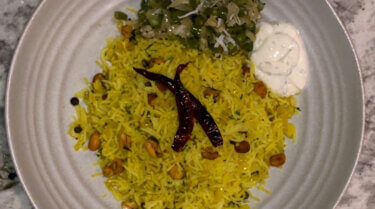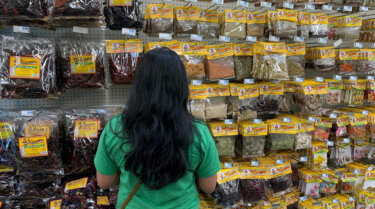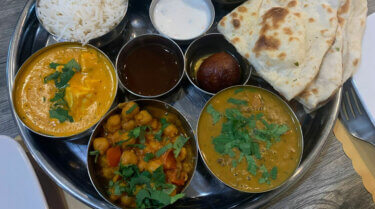Neelam Kadam, associate brand manager at Hormel Foods, has always loved experimenting, whether it be with flavors and ingredients while cooking or exploring other cultures. She grew up in India, which is a tapestry of local cultures and several hundred mother tongues. Her family roots in the country connected her to Mumbai on the west coast and the southern city of Bengaluru (Bangalore). To navigate school, work, family and friendships, she became proficient in six languages.
“My first language is Hindi and my second one is English,” Neelam says, “because they were widely spoken around me. The third one is Marathi, which is my mother tongue that I spoke only with my parents. The fourth one is Kannada, which is spoken widely in Bengaluru where I grew up. I can speak Telugu as well and I can understand Tamil.”
Looking back over her life so far, Neelam can see that she has relied on a seventh language as well: The universal lingua franca of cooking and sharing food. Food, she has learned, is a love language spoken and understood by all.
Multilingual Chef From a Young Age
As she grew up in India, Neelam’s curiosity about flavors led her into the kitchen when she was a child, and to her delight, she discovered she had a knack for making delicious food. “I was really young when I started cooking,” she recalls. “I liked what my mom made, but I always wanted to try new things, mix new things and make something out of it whenever my parents were out of town.”

When asked about her favorite dishes, she describes lemon rice (chitranna), a popular South Indian lunchtime preparation consisting of cooked rice mixed with salt, turmeric, dill leaves, a generous splash of lemon juice, topped with toasted peanuts and a sprinkling of popped mustard seeds, roasted urad dal and crisp curry leaves. “The smell of the frying curry leaves always takes me back to my childhood,” Neelam says.
She also has a fondness for a type of potato smoothie from her early years. “People always look at me weirdly when I describe it,” she says. “You boil the potatoes, and blend them with milk, cream and either sugar or jaggery, an unrefined molasses sugar.”
In 2021, at 28 years old, Neelam emigrated to the United States to pursue her MBA at the University of North Carolina at Chapel Hill. There she explored American cuisine and made friends by cooking and sharing meals with her classmates, although it wasn’t always easy recreating her favorite dishes. That first year was difficult without easy and frequent access to spices and ingredients used in Indian cooking.
She didn’t let the lack of nearby Indian grocery stores thwart her desire to cook and share her favorite comfort food. She joined a few dozen fellow students to bulk order from far-off Indian grocers who would deliver essentials like spices and pickles twice a year. The pickles always ran out first.
When Neelam first arrived in the USA, she imagined American foods like pizzas and burgers to be the staple, but she was pleasantly surprised.
“I learned that America embraces a lot of other cuisines as well,” she says. She was also surprised at the number and quality of the Indian restaurants in North Carolina. In addition, some quintessentially American dishes became favorites. “I first tried green beans with fried onions at a Thanksgiving dinner and couldn’t stop going back for seconds and thirds,” she says. “Something about the dish reminds me of home. Now it is the first thing I serve at my Thanksgiving dinners.”
Adapting to Local Resources
Eventually, she learned that Mexican culture had many flavors and ingredients that she could use as substitutes. “I ended up using Mexican ingredients like dried red chilies and spices like cumin, cloves and cardamom from the Mexican aisle of grocery stores in the area.” By experimenting with what was available, she successfully recreated familiar dishes for her new friends.

To create those dishes, she relied on the one prized kitchen tool that she’d brought from home. To crush cardamom for chai (tea) or to grind cumin and spices to add to rice dishes, she always used the mortar and pestle her mother gave her.
Every year when Neelam visits India, she has a list of favorite foods and dishes she wants to eat. “One thing that is always a constant on that list is the palak dal that my mom makes. She serves it with hot rice, ghee and homemade pickle. She makes it with split chickpeas, spinach and all kinds of spices. I don’t know how to replicate it because she refuses to share her recipe until I am ready to take on the responsibility of an age-old generational recipe.”
Neelam recalled a millet-based, gluten-free flatbread called bhakri that her extended family makes as a treat whenever she visits them. As she explains, bhakri is a labor-intensive dish that starts by mixing jowar flour and salt in a bowl and kneading using hot water. The dough is then split into little balls, flattened, placed on a hot tava (pan) and cooked by applying water to the upper surface. Once done, it is roasted on both sides over an open flame and served with thecha chutney made of roasted chilies and peanuts. It is a deceptively simple dish, she says, but it takes a lot of practice.
Celebrating Diversity
Upon joining Hormel Foods in July 2023, Neelam was delighted at the diversity of backgrounds among her new teammates. “My favorite part about working at Hormel Foods is the people,” she says. “When I was interviewing with Hormel, I spoke to many people and realized that the majority of them had worked for the company for more than 10 years. So that lets you know how well the company takes care of their people.”

As she did when she arrived for school, Neelam once again used her cooking skills to make new friends and build relationships. She invited her co-workers to her new home and cooked her favorite Indian foods like pakoras (fried or baked savory vegetable fritters) and cardamom-infused chai (milk tea). “It was my partner Caleb’s second celebration of Diwali but our first at our home in Austin. We treated ourselves to Indian sweets and I shared stories about Diwali with my new friends and colleagues.”
When asked if there’s any item she wishes to acquire for her new home in Austin, Neelam has an immediate answer. “The cast iron dosa tawa!” she says, describing the flat, round iron skillet. “Those are best for making dosas that are thick and soft on the inside and crispy golden-brown on the outside. That perfection cannot be achieved by using a regular non-stick pan.”
Neelam is excited about an upcoming visit from her parents. “I cannot wait to show them around and take them to all my favorite restaurants here and cook my favorite dishes for them. Although I’m very sure my mom will insist on taking over the kitchen. I would not be opposed to that, for I have missed her cooking.”